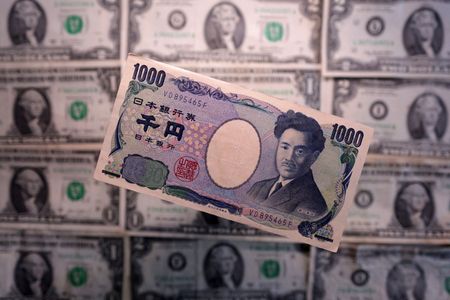By Laura Matthews
NEW YORK (Reuters) -The dollar strengthened against the Japanese yen and the euro on Monday, but was set for its largest quarterly decline since July 2024, as uncertainty around U.S. tariffs kept traders mostly on the sidelines waiting for clarity on President Donald Trump’s trade policies.
The safe-haven yen gained traction in early trading before paring those gains, and gold pushed to a fresh peak as investors shunned risk assets ahead of looming tariffs that have clouded the outlook for U.S. inflation and economic growth.
“Markets are worried about the U.S. economy. They’re more particularly worried about Trump’s tariffs and the effect that they’re going to have going forward, because that entire project is undefined,” said Joseph Trevisani, senior analyst at FX Street.
“Nobody knows exactly what Trump’s going to do. Nobody knows exactly what the response is going to be from the other countries. And more importantly, nobody knows what the economic response is going to be.”
Markets are nervous ahead of a new round of reciprocal levies that the White House is due to announce on Wednesday.
Details are scarce, but Trump said late on Sunday that essentially all countries will be slapped with duties this week.
The yen, which strengthened to 148.7 per U.S. dollar at one point on Monday, was last down 0.1% at 149.95 per dollar. The Japanese currency rallied 0.82% against the dollar on Friday, when U.S. data showed core inflation rose more than expected last month, fuelling fears of stagflation. The dollar fell 4.7% this quarter against the yen, its the largest drop since July 2024.
Gold pushed to an unprecedented $3,128.06 per ounce, marking three consecutive sessions in which it has registered record highs.
“I think we all need some certainty around tariffs and trade and taxes, and maybe we’ll get much of that come April 2,” said Tim Holland, chief investment officer at Orion.
Along with tariffs, investors are in for a busy week with a string of economic reports, including jobs and payrolls data, that could shed much-needed light on how the U.S. economy is holding up under a second Trump presidency.
Federal Reserve Chair Jerome Powell and other central bank officials’ speeches this week also could offer clues on the path for U.S. interest rates.
The euro was down 0.17% at $1.0816, though it is set for a roughly 4.5% rise this quarter, its biggest jump since the third quarter of 2022, thanks to Germany’s fiscal overhaul.
The likely implementation of U.S. tariffs means Europe will have to take better control of its future, European Central Bank President Christine Lagarde said on Monday, reiterating the impact of tariffs and tit-for-tat measures on the bloc’s growth.
Trump on Friday said he was open to carving out deals with countries seeking to avoid tariffs, but the Washington Post reported over the weekend he was urging his advisers to take a more aggressive stance.
The U.S. dollar index, which measures the currency against six major peers, rose 0.2% to 104.2 on the day, but was down 3.1% on the month, its largest fall since November 2022.
“Anticipation of April 2nd tariff announcement has driven the risk tone, but currencies seem to be more in a holding pattern,” said John Velis, head of Americas macro strategy at BNY Markets.
As tariffs roil the global economy, Goldman Sachs raised the probability of a U.S. recession to 35% from 20%. It also projected three interest rate cuts each from the Fed and ECB from, up from its previous expectation of two each.
Elsewhere, the pound <GBP=D3> fell 0.15% to $1.2910 and is set for a nearly 3% monthly climb – its best showing since November 2023.
Britain still expects to be hit by global tariffs this week, although a British government spokesperson said Prime Minister Keir Starmer and Trump had “productive negotiations” towards a trade deal in a phone call on Sunday.
The Canadian dollar eased to C$1.4375 per U.S. dollar. Mexico’s peso slid 0.5% to 20.4566 per dollar.
The Australian dollar was last down 0.7% at US$0.6249 on Monday, ahead of the Reserve Bank of Australia’s (RBA) policy meeting on Tuesday.
Currency
bid
prices at
31 March
08:08
p.m. GMT
Descripti RIC Last U.S. Pct YTD Pct High Low
on Close Change Bid Bid
Previous
Session
Dollar 104.18 104.01 0.17% -3.97% 104.39 103.
index 74
Euro/Doll 1.0816 1.0834 -0.17% 4.47% $1.085 $1.0
ar 784
Dollar/Ye 149.92 149.87 0.09% -4.67% 150.23 148.
n 75
Euro/Yen 162.15 162.24 -0.06% -0.66% 162.48 161.
05
Dollar/Sw 0.8844 0.8802 0.5% -2.53% 0.8856 0.87
iss 75
Sterling/ 1.2917 1.293 -0.1% 3.28% $1.2971 $1.2
Dollar 886
Dollar/Ca 1.4389 1.4319 0.51% 0.08% 1.4396 1.43
nadian
Aussie/Do 0.6248 0.629 -0.65% 0.99% $0.63 $0.6
llar 219
Euro/Swis 0.9564 0.9535 0.3% 1.82% 0.9572 0.95
s 21
Euro/Ster 0.837 0.8365 0.06% 1.17% 0.8379 0.83
ling 5
NZ 0.5677 0.5718 -0.69% 1.48% $0.5724 0.56
Dollar/Do 49
llar
Dollar/No 10.5152 10.4247 0.87% -7.48% 10.57 10.4
rway 411
Euro/Norw 11.3734 11.3306 0.38% -3.36% 11.428 11.3
ay 28
Dollar/Sw 10.0464 10.005 0.41% -8.81% 10.0756 9.97
eden 94
Euro/Swed 10.8671 10.8335 0.31% -5.23% 10.8715 10.8
en 124
(Additional reporting by Kevin Buckland in Tokyo and Yadarisa Shabong in Bengaluru; Editing by Marguerita Choy and Paul Simao)










